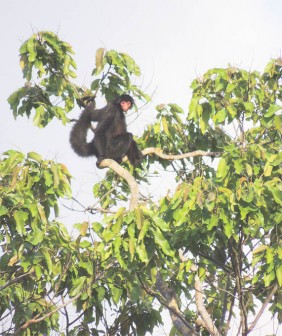The Black Spider Monkey (Ateles paniscus) is also known as the Red Faced Monkey. Both names are suitable for it as it has long glossy black fur, a distinct bright pinky, reddish face and long, gangly, spidery limbs and tail.
The long prehensile tail allows it to grasp and wrap around objects and acts as a fifth limb, stabilizing the monkey as it travels or feeds in the tree tops; the underside of the tail tip does not have fur but is naked and padded like the palm of a hand. Beside their distinctive looks, Black Spider Monkeys have a distinctive way of moving as they swing from branch to branch using their long arms (this is called ‘brachiation‘); they rarely walk upright and are quadrupedal (walk on 4 limbs) when not swinging or brachiating.
![]() They can be seen in undisturbed primary rainforest and don’t use edge or disturbed habitats. In Guyana’s hinterland they prefer low land evergreen rainforest not affected by seasonal flooding, and high mountain forests in savannah areas. Because of their preference for undisturbed canopy habitat and dietary requirements, Black Spider Monkeys require a large home range of nearly 3km2. Surama Mountain and Turtle Mountain, Iwokrama, are two good places to see Black Spider Monkeys and proves that these areas contain relatively undisturbed forest.
They can be seen in undisturbed primary rainforest and don’t use edge or disturbed habitats. In Guyana’s hinterland they prefer low land evergreen rainforest not affected by seasonal flooding, and high mountain forests in savannah areas. Because of their preference for undisturbed canopy habitat and dietary requirements, Black Spider Monkeys require a large home range of nearly 3km2. Surama Mountain and Turtle Mountain, Iwokrama, are two good places to see Black Spider Monkeys and proves that these areas contain relatively undisturbed forest.
Black Spider Monkeys form loose groups of 4 to 25 animals; they are diurnal and during the day may break up into smaller groups to forage and regroup to spend the night sleeping in trees. They inhabit the upper rainforest layers and canopy, foraging on primarily fruits, but if forest fruits are not available, they will eat flowers, leaves, bark, roots, bulbs and honey.
Because fruits are not always available, when they find a fruiting tree they will maximize their caloric intake and spend their time feeding in an upright position, holding on to branches with their tail and collecting fruits with both hands.If disturbed or frightened, they will throw sticks and branches at potential predators on the ground. As they are large, their main predators include large forest hawks and eagles (who will prey on the small and weak) as well as large arboreal snakes.
 The lead female chooses a male from her group for mating. Gestation is 226 to 230 days and females will produce one offspring every 3 or 4 years. The mother’s responsibility is to raise the infant, which relies solely on her care for the first 10 months of its life. For the first month, the mother will carry the infant on her belly, afterwards, she will carry it slung low on her back and it will hold on to her midsection and wrap its tail around the mothers’ for security.
The lead female chooses a male from her group for mating. Gestation is 226 to 230 days and females will produce one offspring every 3 or 4 years. The mother’s responsibility is to raise the infant, which relies solely on her care for the first 10 months of its life. For the first month, the mother will carry the infant on her belly, afterwards, she will carry it slung low on her back and it will hold on to her midsection and wrap its tail around the mothers’ for security.
These monkeys can be found in eastern South America only in Brazil, Guyana, Suriname and French Guiana, and potentially in the eastern tip of Venezuela.The IUCN Red List shows the population of Black Spider Monkeys to be decreasing and the overall status of the animal is listed as Vulnerable. This is probably a due to their small range and habitat destruction given their preference for undisturbed habitat as well as their low reproduction rate.
Rain forests are rich in biodiversity and are home to many different plants and animals as well as indigenous communities. Humans, even those who don’t live in the rain forest, rely on it for resources such as building materials (wood and lianas), medicine and fruits.
Rain forests also provide essential environmental services for life on earth; they create soil as well as prevent soil erosion, produce oxygen though photosynthesis, maintain clean water systems, and are a key defence against climate change.
The Iwokrama Rain Forest is 371,000 hectares, located in the heart of Guyana. Our mission is to develop strategies for conservation and sustainable development for local people in Guyana and the world at large. We are involved in timber, tourism and training. Come and visit us in the rain forest or at http://www .iwokrama.org.





